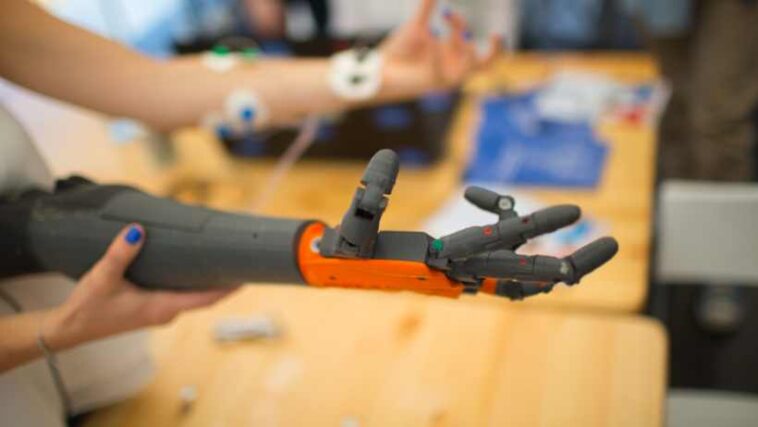Plant-based materials revolutionize soft robotics
Embrace the state-of-the-art realm of soft robotics as materials derived from plants emerge as the primary agents of change that are transforming the discipline. Slight, biocompatible microrobots have been created by a group of researchers from the University of Waterloo using advanced hydrogel composites that contain sustainable cellulose nanoparticles derived from plants. These exceptional robotic systems possess the capability to perform minimally invasive medical procedures, including cell transport and biopsies, while effortlessly navigating through inundated and confined environments.
In addition, the intelligent materials’ exceptional capacity for self-healing enables scientists to program the robots into various geometries and even integrate magnetism to improve their maneuverability. Emerging microrobotics and conventional soft matter will soon intersect, ushering in a new era of medical innovation.
The progression of soft robotics
Soft robotics, an emerging domain within the realm of robotics, is fundamentally transforming our approach to complex tasks, including medical procedures. The utilization of plant-based materials has substantially broadened the scope of potential applications for flexible robotics. These materials possess distinctive characteristics that render them optimal constituents for delicate medical microrobots of the forthcoming generation. The potential of flexible robotics-based materials in medical procedures such as biopsies and cell and tissue transport, as well as the contribution of chemical engineers to this field of study, will be discussed in this article.
An Overview of Plant-Based Substants
Soft robots constructed from materials derived from plants are non-toxic and biocompatible, rendering them suitable for use in medical applications. Particularly sophisticated hydrogel composites, these materials have demonstrated tremendous promise in the field. The sustainability of plant-based materials is a significant benefit.
By incorporating sustainable cellulose nanoparticles derived from plants, these composites are further enhanced in their environmentally favorable characteristics. This presents novel opportunities for minimally invasive medical procedures, which effectively mitigate patient distress and shorten recovery periods.
Non-toxic, biocompatible soft robots
Flexible, non-toxic, biocompatible medical microrobots are a robotics breakthrough. These robotic systems possess the capability to navigate through inundated and confined spaces, including the human body, without inflicting damage upon the adjacent tissues. By utilizing materials derived from plants, these devices are able to interact with biological systems in a secure manner. In medical procedures, where the patient’s wellbeing is paramount, this is an essential determinant.
Employing Sophisticated Hydrogel Composites
Hydrogel composites have demonstrated their criticality in the design of flexible robots. Due to their distinctive characteristics, they are well-suited for scientific and medical uses. The ability of these composites to undergo shape-changing under external chemical stimulation permits scientists to program the change in form.
The ability to program is of the utmost importance in the development of operational soft robotics capable of adjusting to different duties. The integration of botanical substances into hydrogel composites improves their overall functionality, rendering them a highly suitable material for the construction of flexible robots.
Application of Ecological Cellulose Nanoparticles
The utilization of sustainable cellulose nanoparticles obtained from plants is a pivotal factor in the progression of soft robotics. The integration of these nanoparticles into hydrogel composites provides the material with increased strength and stability.
The capacity to manipulate the orientation of cellulose nanoparticles empowers scientists to program the soft robotics’ shape-alteration, thereby augmenting their operational capabilities. Soft robot design that incorporates sustainable materials is consistent with the increasing focus on environmentally benign technologies and sustainable methodologies.
A Comprehensive Strategy for Soft Robot Design
Soft robot development requires design, synthesis, manufacture, and manipulation. Scientists are combining traditional soft matter with emergent microrobots to find new answers. Scientists use hydrogels, colloids, liquid crystals, and liquid crystals to create new microrobots. This comprehensive methodology helps create versatile robots with increased functionality and performance.
Fabrication, Design, Synthesis, and Manipulation of Microrobots
In the pursuit of soft robotics progress, the design, synthesis, fabrication, and manipulation of microrobots are central concerns. Scholars are constructing microrobots capable of carrying out complex operations with extreme accuracy. Scholars are expanding the capabilities of soft robots through the integration of computational, material science, and chemical engineering knowledge. This research field’s interdisciplinary nature facilitates the development of revolutionary solutions and discoveries.
Modifications to the Form of Hydrogel
Hydrogel materials exhibit shape-altering characteristics that facilitate the adaptation of flexible robotics to their surroundings and enable them to execute designated tasks. These materials can undergo shape-change in response to external chemical stimulation, enabling the development of programmable squishy robotics.
The capacity for programmability to perform various tasks in a transformative and adaptable manner grants researchers the ability to design robots with profound implications for the field. Hydrogels’ ability to alter shape provides limitless potential for the development of functional flexible robotics.
Chemical External Stimulation
External chemical stimulation is an effective design aid for sensitive robots. Through the application of chemical stimuli, scientists are capable of regulating the behavior and morphology of soft robotics. This capability allows the robots to be precisely maneuvered for a wide range of purposes, including medical procedures. The capacity to initiate shape-change externally endows squishy robotics with flexibility and adaptability, thereby enhancing their versatility across diverse environments.
Shape-Change Programmability for Operational Soft Robots
Programming soft robots to alter shape represents a substantial development in the discipline. Through meticulous regulation of the process of shape-changing, scientists are capable of fabricating flexible automata that execute designated functions. This presents opportunities for the development of machines capable of transforming their form to traverse intricate environments, enter confined spaces, and execute nuanced tasks. Programmable shape-change functionality enables the adaptation of soft robotics to fulfill particular specifications, thereby enhancing their efficacy and versatility across diverse applications.
Capabilities for Self-Healing and Modification
Soft robots comprised of materials derived from plants possess distinctive capabilities of self-healing and modification. Without the need for adhesive, these materials can be effortlessly reassembled by cutting and pasting to create various shapes to suit diverse procedures. The self-healing functionality of the soft robotics obviates the necessity for external adhesives and augments their longevity and resilience. In addition, the incorporation of magnetism into these substances facilitates intricate procedures by enhancing the mobility of the soft machines within the human body.
Fabric devoid of glue that accommodates an extensive variety of shapes
The application of plant-based materials in the design of soft robots permits the fabrication of adhesive-free materials in an extensive variety of forms. These materials can be sliced and pasted by researchers in order to create specific task-oriented configurations. The capacity to transform their form allows soft robotics to accommodate a wide range of medical procedures, thereby enhancing their remarkable adaptability. By virtue of their lack of glue or other adhesives, these substances are more biocompatible and noxiousness is eliminated.
The incorporation of magnetism to enhance motion
Magnetism can be successfully incorporated into soft robotics constructed from plant-based materials. By enabling the traversal of soft robotics across the human body, this alteration significantly enhances their maneuverability in intricate surroundings. The ability of scientists to manipulate the trajectory of these machines by applying a magnetic field demonstrates the capacity for accurate navigation and targeting. The incorporation of magnetism improves the efficacy and functionality of flexible robots during medical procedures.
The Role of Chemical Engineers in Research
Chemical engineers contribute significantly to the advancement of medical microrobotics research. Their distinct set of abilities and expertise play a crucial role in addressing the obstacles in this burgeoning domain. Chemical engineers are well-versed in biochemical systems, heat and mass transfer, fluid mechanics, reaction engineering, polymers, and soft matter science. Their wide-ranging background enables them to propose novel approaches in the design and construction of flexible robots. Their invaluable contributions to the field have significantly advanced the domain of soft robotics.
Advancements in the Field of Medical Microrobotics
Daily discoveries are made of previously uncharted territories within the field of medical microrobotics. Bio-based soft robots possess the capacity to fundamentally transform medical procedures. Regarding cell and tissue transport as well as minimally invasive biopsies, these devices provide accurate and effective solutions.
In medical microrobotics research, the creation of functional soft robots capable of navigating complex environments and adapting to specific tasks represents a significant milestone. In this discipline, innovation is propelled by the combination of chemical engineers’ knowledge and the incorporation of plant-based materials.
Chemical engineers’ competencies and expertise in microrobotics
Chemical engineers contribute a distinct repertoire of expertise and competencies to the domain of microrobotics. Their profound knowledge across multiple fields enables them to make substantial contributions to the conceptualization, construction, assembly, and control of microrobots. Chemical engineers have an indispensable comprehension of reaction engineering, fluid dynamics, and material properties, all of which are critical for the development of sophisticated soft robotics. By integrating emerging microrobots with conventional soft matter, they facilitate a comprehensive approach to research and stimulate innovation within the domain.
Reducing in Size the Robots
Research into flexible robotics will progress to the submillimeter scale of robots. This gives rise to an entirely fresh array of obstacles and prospects. Scholars are engaged in the development of more compact robotic systems capable of intricate tasks being executed with pinpoint accuracy.
Addressing the challenges associated with reducing down robots requires interdisciplinary research and collaborative efforts. The emergence of submillimeter-scale soft robots facilitates novel research and practical applications, thereby setting the stage for forthcoming advancements in miniaturized robotics.
Partnerships with Scholars and Professors
Collaboration is an indispensable component of scientific inquiry, and the same is true for soft robotics. Scholars and professors hailing from various academic establishments convene in order to exchange resources, concepts, and knowledge. A collaborative research approach facilitates the integration of diverse perspectives and skill sets through a multidisciplinary framework.
Collaborative efforts among researchers enable them to tackle intricate challenges and propel the domain forward at an accelerated rate. Creativity and innovation are fostered by the rich and varied research landscape that is the result of the contributions of various institutions.
The input provided by various institutions
The progress of soft robotics is facilitated by the contributions of numerous institutions, each of which contributes its own distinct set of resources and expertise. Innovative findings and the transmission of knowledge are the results of collaborative efforts between scientists from various institutions. Synergy generated by these collaborations propels soft robotics forward and influences its trajectory. Beyond the capabilities of soft robotics, future research and development in this domain is established on the groundwork of contributions from various institutions.
To conclude,
Particularly through the integration of plant-based materials, soft robotics has undergone a revolutionary transformation. These materials are ideal for medical procedures due to their biocompatibility, nontoxicity, and programmable shape-change capabilities. Soft robots constructed entirely of plant-based materials possess the capability to perform delicate procedures with minimal incision, including biopsies and the transportation of cells and tissues.
Chemical engineers are instrumental in advancing the boundaries of medical microrobotics research by developing novel solutions using their expertise and skills. Scholarly collaboration among researchers and professors hailing from diverse institutions cultivates innovation and propels advancements within the discipline. As soft robotics advances, these minuscule robots are endowed with limitless potential, which creates novel opportunities for medical procedures and other complex undertakings.
Preferred Sources
Hamed Shahsavan, Negin Bouzari, Xiaowu Tang, Tizazu H. Mekonnen, Rasool Nasseri, Junting Huang, Hossein Golzar, and Sarah Jankhani. Soft robotics-related programmable nanocomposites of cellulose nanocrystals and zwitterionic hydrogels. 14 (1) Nature Communications, 2023 DOI: 10.1038/s41467-023-41874-7
Institution of Waterloo. “Plant-based materials give ‘life’ to tiny soft robots.” The Science Daily. Scientific Daily, October 23, 2023. Science Daily, 2023, Vol. 10, No. 2311-244-12.html



